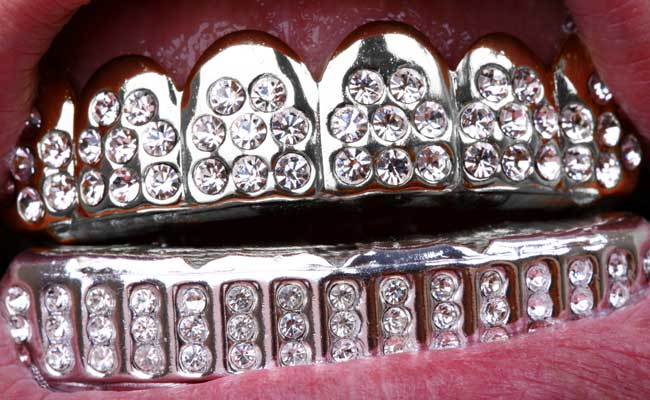Dental Consumer Products Overview: Denture Products
If you have dentures, or even if you haven’t, chances are you’ve seen TV advertisements for denture products. Because dentures and teeth loss can be emotional topics, it’s no surprise that the advertisements try (let’s call them) unconventional approaches. Sometimes they try too hard to be funny, sincere, or authoritative. Other times they go for realness and end up somewhere closer to too-much-information.
But for all their flaws, these ads are speaking to a sizable market. Over 60 million people in the US lack teeth, and according to the Journal of Prosthetic Dentistry, there will be 37.5 million people wearing full dentures by 2020. For people with dentures, consumer products on the market attempt to address two primary needs:
- Keeping dentures clean
- Keeping dentures in your mouth (preferably comfortably!)
Cleaning products come in a few varieties. Martha Raye, denture wearer, advocated for a brand of dissolving tablets that killed bacteria and remove stains. There are also pastes, much like toothpaste, that patients can use to brush their dentures—once the dentures are safely out of your mouth. Ultrasonic cleaning appliances can remove stains from dentures, although they are more expensive and also require the use of a special cleaning fluid. For patients concerned with chemical cleansers, homemade solutions using lemon juice, vinegar, or baking soda can all help remove stains and re-whiten dentures.
Denture adhesives include pastes or gels that come in a tube, like toothpaste and adhesive strips. These adhesives are meant to keep dentures in patients’ mouths comfortably while eating and talking.
Dentures are meant to fit comfortably in the mouth—and not require adhesives—because they are molded specially to the patient’s jawbone and palate. However, without teeth anchored in the jaw, the bone deteriorates over time, and its shape changes. This eventually leads to dentures that don’t fit, or that cause discomfort, requiring adhesive. Even cleaning dentures, which requires them to be removed from the mouth, could conceivably cause patients to experience negative feelings.
However, changes in dental technology can reduce these issues for patients. Fixed implant dentures use dental implants to secure replacement teeth permanently to the jaw. Patients can brush them in their mouth, just like teeth, and the implants themselves help the jawbone avoid further deterioration. Although implants do tend to be more expensive than traditional dentures, for many they are an appropriate, life-long solution to their dental needs.
Whether you’re looking for the best way to take care of your dentures or you’re considering whether implants might be a better solution for you, we’d love to talk to you. Call your Lancaster, CA dentist today at 661.952.7865 for an appointment to find out more!
More
Five Signs You Might Have Sleep Apnea… and One Thing You Can Do About It
At one point in time, maybe even only a few years ago, sleep apnea was not well-known among the public. Now, thankfully, public awareness of sleep apnea is much higher. After all, it is a dangerous condition, and because it is a disease that affects sleep, many people who have sleep apnea aren’t even aware of it.
If you suffer from sleep apnea, you will temporarily stop breathing during the night—up to hundreds of times! The health implications are quite serious, as sleep apnea is linked to many cardiovascular diseases, including high blood pressure, heart failure, stroke, and heart arrhythmias. So if you have sleep apnea, it’s important to get treatment.
So what are some signs or risk factors for sleep apnea?
- You’re overweight.
Body weight is linked to obstructive sleep apnea, which is caused by tissues in the upper throat collapsing, constricting the flow of air to the lungs. Heavier people can have tissue built up around their neck and throat; these tissues fall back and obstruct the airway when they’re lying down.
- You have high blood pressure.
When you stop breathing during an episode of sleep apnea, less oxygen gets to your brain. Since your brain needs to maintain sufficient oxygen levels at all times, this can lead to spikes in blood pressure as your body tries to compensate for low oxygen levels by pumping more blood, faster, to your brain.
- You’re often tired during the day.
Even if you think you’re getting plenty of sleep at night, you probably aren’t if you’re suffering from apnea. Not only do the interruptions detract from the amount of sleep you’re getting; they also detract from the quality of sleep. If you have difficulty waking up in the morning, feel tired all day long, need frequent naps, or doze off on occasion, you might have apnea.
- You’re frequently irritated, depressed, or prone to mood swings.
If you’re not getting enough sleep, it can quickly have an impact on your mood. Your body releases cortisol, a hormone that causes stress, if you’re sleep deprived. This means you might end up feeling anxious, irritable, or just out of sorts frequently.
- You snore.
If your spouse or significant other tells you that you snore, or if your snoring wakes you up, then that’s a good sign you might have sleep apnea. In fact, snoring is the most common sign of sleep apnea.
And now, for one thing you might not know about sleep apnea: there are treatment options other than a CPAP machine. In fact, if you have sleep apnea, you can call your dentist for help. There are simple oral appliances (mouth guards) that can position your jaw in such a way that it keeps your airway open during the night.
So if you’re concerned about sleep apnea, you might just want to talk to your Lancaster, CA dentist about it next time you’re in the office for a check-up. Call Douglas B. Weber, DDS at 661.952.7865 today, and we’ll be happy to help!
More
By admin
30 Aug, 2017
Dental Health, Dental Hygiene, Dental Tips, General Dentistry, Orthodontics
back to school, dental assistants, dental professionals, dental school, dentists, hygienists
As the calendar turns to August and the summer starts to wind down, parents (with fondness) and children (with dread) begin to think about notebooks, pencils, and new outfits… everything that goes along with Back to School season. But did you know that dentists, hygienists, and dental assistants spend a lot of time thinking about going back to school as well?
Forty-seven states require dentists to complete some amount of continuing education courses before they can renew their licenses. For hygienists, the total is higher still, with 48 states mandating continuing education. (Dental assistants get off a little easier; only 22 states have a minimum continuing education requirement.)
So what exactly are dentists and their teams studying… and why should it matter to you?
Read on to find out more!
In order to ensure that dentists, hygienists, and dental assistants are providing the best possible care to their patients, state licensing boards typically require these professionals to pass an exam to get their license. The certification lasts for one to five years, with two- and three-year terms being most common. Rather than require dental professionals to retake board examinations every couple years, most state licensing boards mandate dental professionals to take a certain amount of credit hours in continuing education to retain their license.
Many organizations provide continuing education courses, including the American Dental Association, dental graduate schools, and other professional dental associations and institutions. All of these organizations must be certified to provide professional-level training before the credits can count towards meeting licensing requirements.
Many states require dentists to include fundamental training in their continuing education—things like CPR and infection control. However, other topics are popular as well. Many institutes offer training in new dental techniques or technology; instruction in specialty dentistry like implants, orthodontics, or endodontics; or how to run their practice more effectively. Hygienists and dental assistants take continuing education classes that provide practical and technical instruction in their roles on a practice team. Courses can take place in person, online, or at special training events.
Why should this matter to you, as a patient?
It matters because when you go to a dentist, you can be sure that you’re getting top quality care from professionals that care enough to stay informed and trained in their field of expertise.
Dentists, like other medical professionals, are committed to the health and well-being of their patients, and continuing education requirements demonstrate that commitment. In fact, if you ask your dentist or hygienist, chances are that they’re not just meeting the requirements of their state dental board—they’re exceeding them!
If you’re curious about new technology in dentistry, new dental techniques, or what your dental care providers are studying, feel free to ask next time you’re in the office. We’ll be happy to tell you all about it.
Make an appointment with us today, and you can be sure you’ll be getting the highest quality dental care. Request an appointment today on our website or by calling the office at 661.952.7865!
More
By admin
15 Aug, 2017
Cosmetic Dentistry, Dental Health, Dental Hygiene, Dental Tips, General Health, Lifestyle, Oral Health
caring for dental grills, dental grills, dental history, gold teeth, grillz

A Brief History of Grills
“I got my mouth looking something like a disco ball
I got the diamonds and the ice all hand set
I might cause a cold front if I take a deep breath
My teeth gleaming like I’m chewing on aluminum foil”
– Grillz, Nelly (featuring Pall Wall & Ali & Gipp)
Grills (or grillz) are, if not popular, at least fairly recognizable these days. Made of precious metals (gold and platinum being the most common) and often studded with diamonds, most grills are removable and worn over the front teeth. But where do they come from?
Although many people would point to Nelly and his 2005 song, “Grillz,” as the starting point for the trend, they’re actually much older than that. (And no, we’re not just talking about rappers like Slick Rick, Flavor Flav, and Big Daddy Kane from the 80s and 90s, either). We’re talking ancient history.
In ancient Italy, between 800 and 200 BC, wealthy Etruscan women wore teeth woven together with gold wire the thickness of a rubber band. The wire held together teeth that had been removed and were placed back into the mouth, so they made eating difficult. The practice wasn’t necessarily common, but archaeologists found documentation of around 20 sets of teeth woven together in this way. Etruscan civilization vanished as the Romans took over Italy, and this fashion trend died with it.
In Latin America, Mayans actually cut small holes into their teeth and filled them with precious stones, typically jade. Again, this was a trend that only royalty and the wealthy could afford. Although the Mayan civilization has disappeared, many people in southeastern Mexico, Belize, Honduras, and Guatemala still wear gold tooth jewelry today.
In ancient Filipino myths, the creator of the world, a deity named Melu, had gold teeth—and during what was the Middle Ages in Europe, Filipinos were filing down their teeth and decorating them with gold. Some of these decorations included gold bands that covered the entire front row of teeth; the oldest date to around 1300 AD.
As the Renaissance began in Europe, dentistry was becoming more scientific and less superstitious—and Giovanni de Arcoli, a 15th century Italian professor of medicine, became the first author known to recommend filling cavities with gold to preserve them.
Grills started appearing in rap and hip hop videos in the 80s, and became even more popular as Southern rap began to take off in the 90s and early 2000s. And now, they’ve jumped into mainstream culture, as celebrities like Madonna, Miley Cyrus, Katy Perry, and even Ryan Lochte have sported them in recent years.
You might expect a dentist to come out against grillz as a health hazard, but no studies have proven that they’re bad for your teeth. As long as they’re removed and the teeth are brushed and flossed as appropriate, they shouldn’t cause health problems. Some metals can cause irritation; if it causes a rash, or bleeding, or other problems, just stop. Similarly, don’t clean them with anything toxic to ingest (like most jewelry cleaners), and don’t try to attach them permanently to your teeth with glue. But if you want to wear a grill, and you use some common sense and take care of your teeth, you’ll be part of a long tradition of dental jewelry.
We can’t recommend a jeweler to create your grill, but if you have any questions about dental instruments—either ornamental or for health reasons—please give us a call at (661) 952-7865 and we’ll be happy to answer your questions.
More
Do you ever stand in the oral care section at a store—maybe your local supermarket, maybe a general retailer or a pharmacy—and wonder why there are so many different types of toothpaste? Think about how many brands there are—and then how many different types of toothpaste there are for each brand! Crest 3DWhite, Pro-Health, Pro-Health Advanced, with Scope, Sensi, regular old Crest, Kids’ Crest… the list goes on and on.
A helpful way to think about your toothpaste choice is to think about your goals, beyond basic hygiene, when you brush. Do you want fresh breath or whiter teeth? Do your teeth hurt when you brush? Do you want to avoid a long cleaning next time you’re at the dentist? When you answer those questions, you’ll start to narrow down that overwhelming selection of toothpastes to a more manageable few.
There are a few basic types of toothpastes out there today. However, it’s important to realize that many toothpastes fit into one or more of the categories. (This is why there are more than 40 different types of Crest alone, after all.)
Fluoride Toothpaste
Fluoride toothpastes contain fluoride compounds to help prevent tooth decay. Fluoride works by strengthening, and even helping repair, tooth enamel. These toothpastes vary in the amount and type of fluoride compounds they contain and can come in a variety of flavors that appeal to both adults and children.
Whitening Toothpaste
If you’d like your teeth to look a little whiter, whitening toothpastes can help. They’re not as effective as dedicated whitening products (like whitening strips), but they can help you maintain whitened teeth. However, keep in mind that many whitening toothpastes can be more abrasive than regular toothpastes. If you use them, give your teeth an occasional break by using less abrasive toothpastes as well!
Desensitizing Toothpaste
Some people experience pain when their teeth are exposed to cold, heat, or touch—even the gentle pressure applied when brushing their teeth. If you experience this condition, called dentin hypersensitivity, you can use desensitizing toothpaste to make brushing a more pleasant (or at least not painful) activity.
Anti-plaque Toothpaste
Anti-plaque toothpastes help prevent plaque from accumulating around your teeth, reducing the risk of both tooth decay and gum disease. There are a variety of anti-plaque compounds out there, including Triclosan (an anti-bacterial compound) and zinc citrate (which supports your immune system).
Kids’ Toothpaste
Toothpastes for kids may or may not have fluoride in them—and that’s actually not a problem. First of all, the physical action of brushing (and flossing) loosens plaque and helps protect your teeth. Typically, toothpastes made for children have fruity flavors and lower levels of fluoride in case of swallowing.
To be honest, the most important choice you make is to brush and floss regularly. The best toothpaste for you to use is one that supports your goals for oral health, and that you will use twice a day, every day.
Of course, if you’d like to find out more about toothpaste, or want specific recommendations, we’re happy to help. Call your Lancaster, CA dentist at 661.952.7865 today!
More





